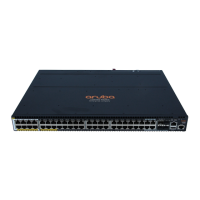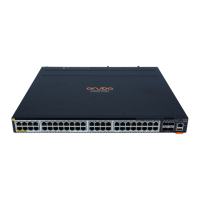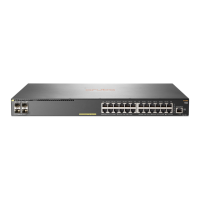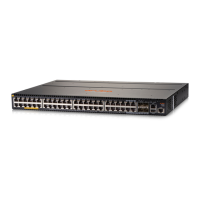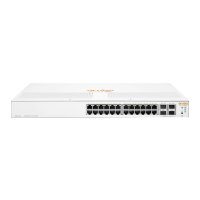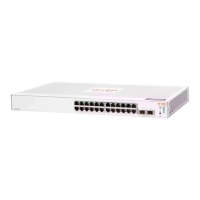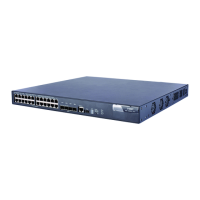Do you have a question about the HP Aruba 8325 Series and is the answer not in the manual?
Lists the specific Aruba 8325 switch models covered in the manual.
Lists other relevant documentation for the Aruba 8325 switches.
Provides a general description of the Aruba 8325 switch capabilities and features.
Details the components and indicators on the front panel of the switch.
Describes the different types of network ports available on the switch.
Details optional network connectivity options and transceiver support.
Describes the console and out-of-band management ports on the switch.
Identifies and describes chassis LEDs on the front panel of the switch.
Explains the port LEDs on the front panel of the switch and their behavior.
Describes the function and usage of the reset button.
Details the information found on the switch product label.
Describes the components and labels located on the rear of the switch.
Explains the function and types of power supplies for the Aruba 8325 switch.
Describes the status LED behavior for power supplies.
Explains how load sharing works between power supplies.
States that mixing AC and DC power supplies is not supported.
Describes the redundancy provided by multiple power supplies.
Explains the hot-swapping capability of power supplies and fans.
Discusses the fan assemblies, their types, and installation requirements.
Explains the status LED behavior for fan assemblies.
Lists and describes the key features and capabilities of the Aruba 8325 switch.
Lists the parts included with the Aruba 8325 switch.
Lists parts that are not included and need to be ordered separately.
Outlines the step-by-step procedure for installing the switch.
Provides essential safety guidelines and precautions for installing the switch.
Details how to prepare the physical environment for switch installation.
Guides on installing the power supplies into the switch.
Guides on installing the fan assemblies into the switch.
Instructions for powering on the switch and verifying its status via LEDs.
Specific instructions for connecting AC power supplies.
Specific instructions for connecting DC power supplies.
How to check switch LEDs to confirm proper operation.
Steps to safely power off the switch.
Instructions for mounting the switch in a rack or cabinet.
Overview of the switch mounting options.
Detailed steps for mounting the switch in a two-post rack.
Detailed steps for mounting the switch in a four-post rack.
Guides on installing and removing SFP/QSFP transceivers.
Information on hot-swapping transceivers.
How to connect transceivers to devices with fixed speed/duplex.
Explains how to configure interface groups for speed settings on specific models.
Details restrictions for 1GBase-T transceivers on 48-port models.
Details restrictions for 10GBase-T transceivers on 48-port models.
Step-by-step guide for installing transceivers into the switch.
Step-by-step guide for removing transceivers from the switch.
Instructions for connecting the switch to a power source.
Methods for performing the initial configuration of the switch.
Instructions for connecting network cables to the switch.
Details on using the out-of-band management port for network connectivity.
Guidance on connecting network cables to transceivers.
Settings required for terminal emulation software for console connection.
Steps to connect to the switch via the console port.
Describes the pinout mapping for console cables.
Instructions for replacing a power supply unit.
Instructions for replacing a fan assembly.
Provides fundamental tips for diagnosing and resolving common switch problems.
Explains how to interpret LED patterns for troubleshooting switch issues.
Describes hardware diagnostic tests that can be performed on the switch.
How to reset the switch to test its circuitry and operating code.
Refers to the LED diagnosis section for checking switch LEDs.
Guidance on checking console messages for diagnostic information.
Procedures for testing network communication between the switch and devices.
Methods for testing the complete communication path through the switch.
Information regarding the internal lithium battery and its replacement.
Information on how to download and install new software for the switch.
Contact information and guidance for obtaining technical support.
Details the physical dimensions and weight of the switch models.
Provides electrical specifications for the switch and power supplies.
Specifications related to the power consumption of the switch.
Mean Time Between Failures specifications for the switch.
Environmental operating and non-operating specifications for the switch.
Acoustic specifications, including sound pressure levels.
Information regarding RoHS compliance.
Lists technology standards and laser safety compliance information.
Details the specifications for various types of network cabling.
Provides distance specifications for different technologies and cable types.
Information on how to access Aruba support services and contact details.
Lists other websites for finding relevant information.
Explains how to access software updates for the switch.
Provides access to the Aruba Support Portal for product information and downloads.
Information on accessing HPE My Networking for entitlements and support.
Details on how to find warranty information for the product.
Information on regulatory compliance for the switch.
Instructions for providing feedback on the documentation.
